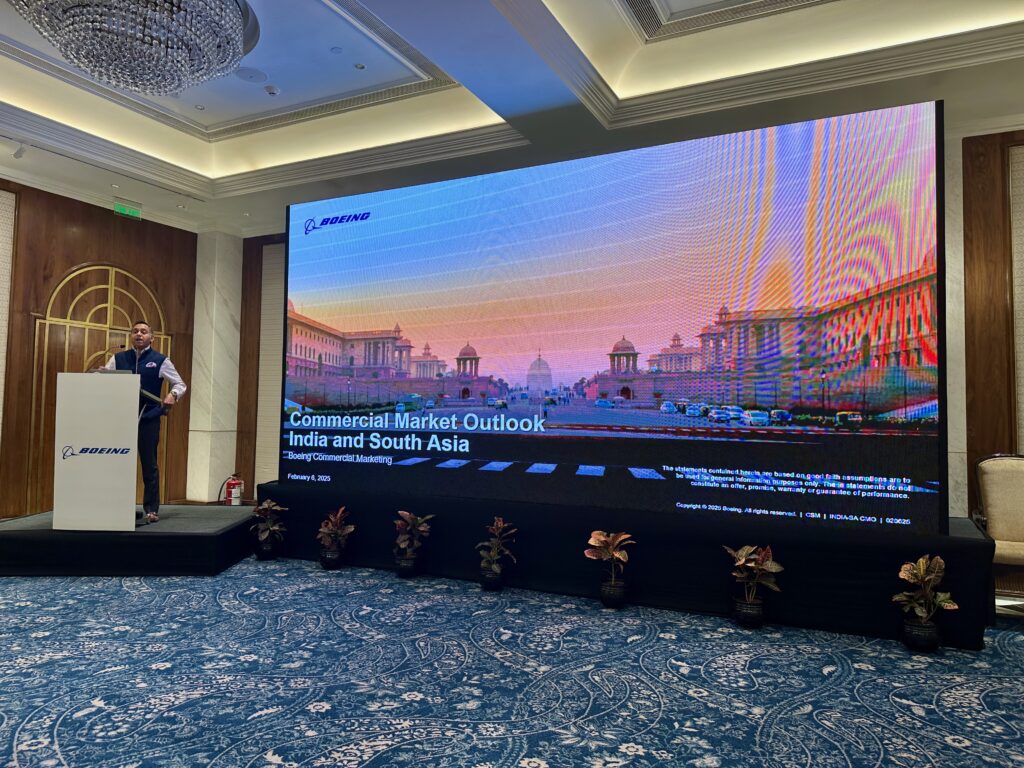Boeing has been having a rough few years, and that is something we’ve all known by now, but the future is bright, they predict. Boeing held its annual Commercial Market Outlook discussion for the Indian and South Asian markets, sharing a lot of insights about what is happening right now and what they expect to see in the future.

Boeing’s commercial forecast for India
Boeing expects Indian and South Asian airlines to add 2,835 commercial aircraft to their fleets by 2043. The OEM predicts that most of these aircraft will be added to India. Boeing forecasts that the rising middle class, healthy economic growth, and the addition of new airports will spur travel. According to Boeing, the new airports in Mumbai and Delhi are expected to be game changers, as adding this capacity across the two metropolises could redefine the airlines’ networks. The company expects the region’s demand for widebody aircraft to quadruple in the next 20 years.
According to its global commercial outlook, there will be a strong demand for 44,000 aircraft globally through 2043. By region, Asia Pacific and Eurasia are expected to see the highest demand, with 22% of all orders, followed by 21% and 20% for North America and China, respectively.
Boeing expects to deliver only two aircraft per month to Indian airlines.
When asked about deliveries to Indian carriers, Boeing forecasts that it expects to deliver an average of two aircraft per month to Indian customers in 2024 and 2025. This would also include its widebody aircraft, if any are delivered to India.
As of the close of 2024, here is the breakdown of unfilled aircraft orders from Indian airlines on the Boeing books:
- Air India Group: 154 737 MAX aircraft
- Air India: 10 777X, 20 787-9 aircraft
- Akasa Air: 200 737 MAX aircraft
There are also 129 737 MAX aircraft pending to be delivered to SpiceJet, which they have not picked up in a long time, but the airline recently commented that they will talk to Boeing to restart aircraft deliveries.
Ashwin Naidu, who is the Managing Director for commercial marketing for India and South Asia, said,
The India and South Asia region continues to be the world’s fastest-growing commercial aviation market due to strong economic and trade growth, rising household incomes and investments in infrastructure and development.
As Boeing was recovering from the impact of the 737 MAX groundings due to multiple fatal incidents and CoVid, the OEM found itself in another storm in 2024. A Boeing 737 aircraft had a door unplug incident on US soil, triggering a wide-ranging reaction from the US Administration via the Federal Aviation Authority, its regulator.
One impact was that Boeing was currently capped at a production rate of 38 aircraft for the 737 MAX until the FAA was convinced that the OEM had improved its quality checks and processes. Boeing is trying to solve this by various quality enhancement programmes and trying to stop “travelled work.” The OEM is also moving forward to bring Spirit Aerosystems, one of its most essential suppliers, back into the company.
Production has been impacted due to industry-wide supply chain issues and a seven-week-long strike related to the negotiations around the machinist pay, which further affected output at both the Everett and Renton facilities.
Boeing apologised for slowing Air India’s growth because it could not deliver its aircraft on time. Late last year, Air India CEO Campbell Wilson said the airline had to recalibrate its ambitious growth plans due to delays in aircraft deliveries and supply chain disruptions, which hindered its transformation efforts.
Bottomline
Boeing expects India and South Asia to need over 2800 aircraft in 20 years. The OEM is very optimistic about the growth in India due to the low number of trips per annum for now, the rising middle class and the infrastructure growth in India. However, the airlines in India should not expect to grow at tearing speeds in the coming years with Boeing, given that the OEM does not think for now that it will be able to deliver more than 24 aircraft per annum for the next two years.
What do you think of Boeing’s updates? Are there things they could do better?
Liked our articles and our efforts? Please pay an amount you are comfortable with; an amount you believe is the fair price for the content you have consumed. Please enter an amount in the box below and click on the button to pay; you can use Netbanking, Debit/Credit Cards, UPI, QR codes, or any Wallet to pay. Every contribution helps cover the cost of the content generated for your benefit.
(Important: to receive confirmation and details of your transaction, please enter a valid email address in the pop-up form that will appear after you click the ‘Pay Now’ button. For international transactions, use Paypal to process the transaction.)
We are not putting our articles behind any paywall where you are asked to pay before you read an article. We are asking you to pay after you have read the article if you are satisfied with the quality and our efforts.


Leave a Reply